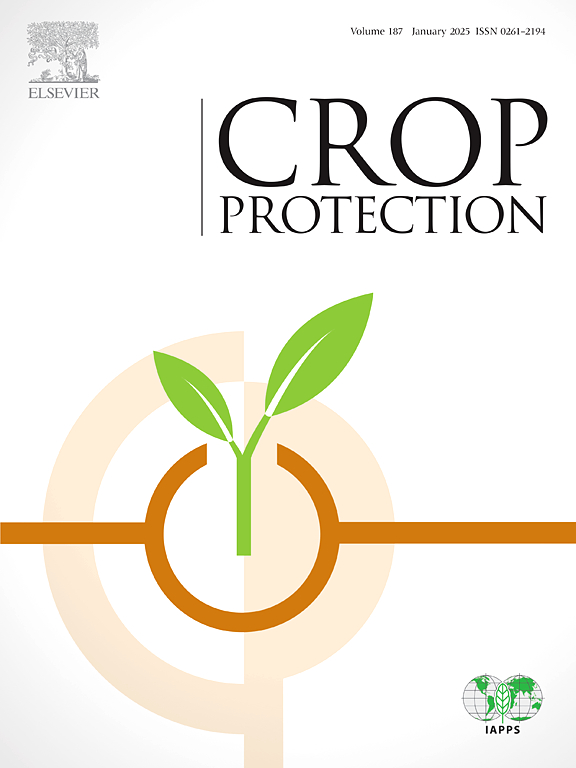Weeds and rice response to post-emergence applications of pendimethalin alone and in herbicide mixtures in water-seeded rice
IF 2.5
2区 农林科学
Q1 AGRONOMY
引用次数: 0
Abstract
Herbicides are an important tool for weed management in water-seeded rice (Oryza sativa L.); however, the reduced efficacy from available herbicides and the lack of new herbicides have encouraged research on new use of older herbicides for this production system. This research evaluated weed control and water-seeded rice response to pendimethalin applied post-emergence in a field trial. Pendimethalin was applied alone and in herbicide mixtures at 1.1, 2.3 and 4.4 kg ai ha−1 with three graminicide or broad-spectrum foliar herbicides to rice at the 4- to 5-leaf stage. A greenhouse study was conducted to evaluate rice response to pendimethalin applied at 1.1 and 2.3 kg ai ha−1 at the 4- to 5-leaf stage grown under 5-cm and 10-cm flood depth conditions. Grass weed control at 14 days after treatment was 68%–86% when pendimethalin was applied in herbicide mixtures compared to 48%–63% when applied alone. The mixtures with bispyribac-sodium and propanil provided broad spectrum control of grass, sedge, and broadleaf weeds unlike the mixture with cyhalofop-butyl, a graminicide herbicide. All treatments resulted up to 8% of visual rice injury. Rice tiller counts and grain yield were not affected by pendimethalin. The 5-cm and 10-cm flood depth, in the greenhouse study, affected shoot length, root length, and root biomass but not shoot biomass averaged over pendimethalin applications; however, rice was normal by 14 or 21 days after treatment. Only shoot length was reduced by 12% at 21 days after treatment at 3.4 kg ai ha−1 of pendimethalin. The results from these studies demonstrate pendimethalin can be a potential herbicide for water-seeded rice and does not cause injury of concern on rice when applied at the 4- to 5-leaf stage rice.
杂草和水稻对出苗期单独施用除草剂和与除草剂混合施用除草剂的反应
除草剂是水种水稻(Oryza sativa L.)杂草治理的重要工具;然而,现有除草剂的有效性降低和缺乏新的除草剂,鼓励了对这种生产系统使用旧除草剂的新用途的研究。本研究在田间试验中评价了出苗后施用戊二甲基灵对水种水稻的杂草控制和反应。在水稻4 ~ 5叶期单独施用和与3种杀菌剂或广谱叶面除草剂分别以1.1、2.3和4.4 kg ai ha - 1的除草剂混合施用二甲甲烷。通过温室试验,研究了在5 cm和10 cm洪水深度条件下,水稻在4 ~ 5叶期施用1.1和2.3 kg / hm - 1杀虫剂对水稻的反应。与除草剂混合施用时,14 d的杂草防治率为68% ~ 86%,而单独施用时为48% ~ 63%。双嘧菌酯钠和丙烯的混合物提供了对草、莎草和阔叶杂草的广谱控制,而不像氯氟膦丁基(一种杀谷物除草剂)的混合物。所有处理导致高达8%的视觉损伤。对水稻分蘖数和籽粒产量没有影响。在温室研究中,5 cm和10 cm淹水深度对茎长、根长和根生物量有影响,但对喷二甲甲烷的平均茎生物量没有影响;然而,水稻在处理后14天或21天恢复正常。在3.4 kg / ha - 1的戊二甲基灵处理21天后,只有茎长减少了12%。这些研究结果表明,在水稻4 ~ 5叶期施用戊二甲基灵对水种水稻是一种潜在的除草剂,不会对水稻造成令人担忧的伤害。
本文章由计算机程序翻译,如有差异,请以英文原文为准。
求助全文
约1分钟内获得全文
求助全文
来源期刊

Crop Protection
农林科学-农艺学
CiteScore
6.10
自引率
3.60%
发文量
200
审稿时长
29 days
期刊介绍:
The Editors of Crop Protection especially welcome papers describing an interdisciplinary approach showing how different control strategies can be integrated into practical pest management programs, covering high and low input agricultural systems worldwide. Crop Protection particularly emphasizes the practical aspects of control in the field and for protected crops, and includes work which may lead in the near future to more effective control. The journal does not duplicate the many existing excellent biological science journals, which deal mainly with the more fundamental aspects of plant pathology, applied zoology and weed science. Crop Protection covers all practical aspects of pest, disease and weed control, including the following topics:
-Abiotic damage-
Agronomic control methods-
Assessment of pest and disease damage-
Molecular methods for the detection and assessment of pests and diseases-
Biological control-
Biorational pesticides-
Control of animal pests of world crops-
Control of diseases of crop plants caused by microorganisms-
Control of weeds and integrated management-
Economic considerations-
Effects of plant growth regulators-
Environmental benefits of reduced pesticide use-
Environmental effects of pesticides-
Epidemiology of pests and diseases in relation to control-
GM Crops, and genetic engineering applications-
Importance and control of postharvest crop losses-
Integrated control-
Interrelationships and compatibility among different control strategies-
Invasive species as they relate to implications for crop protection-
Pesticide application methods-
Pest management-
Phytobiomes for pest and disease control-
Resistance management-
Sampling and monitoring schemes for diseases, nematodes, pests and weeds.
 求助内容:
求助内容: 应助结果提醒方式:
应助结果提醒方式:


